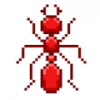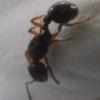Hi friends,
I have this queen with two workers in a test tube. I caught her some weeks ago and I'd like some help to identify her.
1. Location of collection: Yucatan, Merida in the backyard of my house after a rainy day.
2. Date of collection: in August 2017.
3. Habitat of collection: around my zone are a lot of vegetation and trees.
4. Length: the queen is around 3-4 mm
5. Coloration, hue, pattern and texture: Shiny black
6. Distinguishing characteristics: seems to have two petiole nodes
7. Anything else distinctive: sometimes bend the gaster below the body
8. Nest description: NA
Sorry for the quality of the pictures, I'll try to take better ones if needed.
Thanks,
Rodolfo.






































